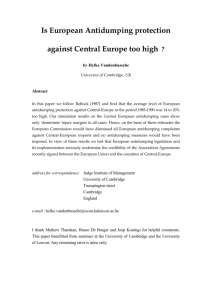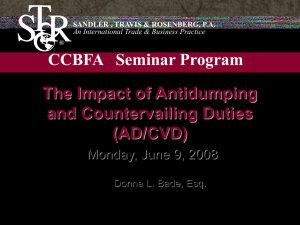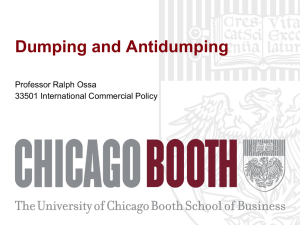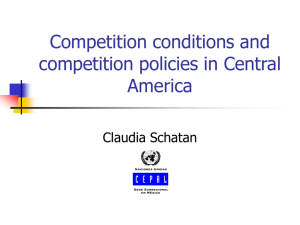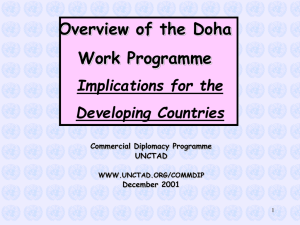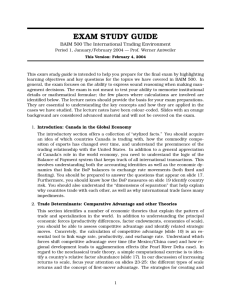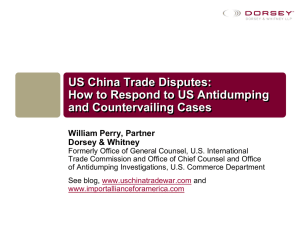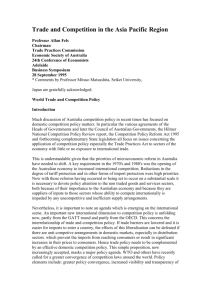U.S. Antidumping Filings and the Threat of Retaliation
advertisement
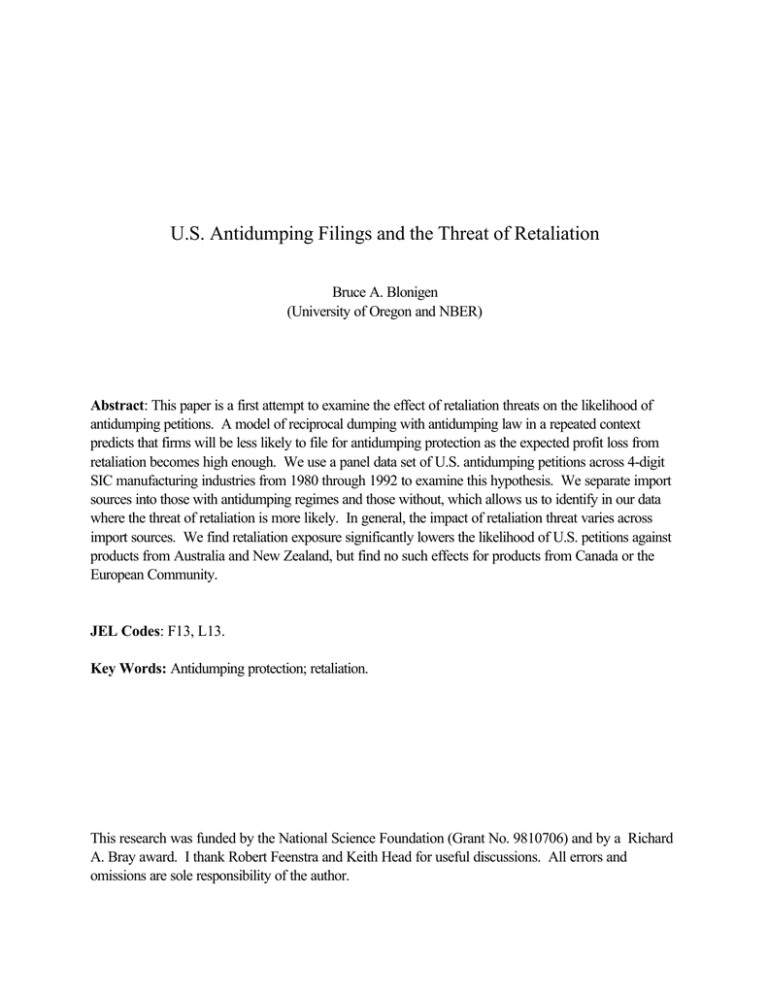
U.S. Antidumping Filings and the Threat of Retaliation Bruce A. Blonigen (University of Oregon and NBER) Abstract: This paper is a first attempt to examine the effect of retaliation threats on the likelihood of antidumping petitions. A model of reciprocal dumping with antidumping law in a repeated context predicts that firms will be less likely to file for antidumping protection as the expected profit loss from retaliation becomes high enough. We use a panel data set of U.S. antidumping petitions across 4-digit SIC manufacturing industries from 1980 through 1992 to examine this hypothesis. We separate import sources into those with antidumping regimes and those without, which allows us to identify in our data where the threat of retaliation is more likely. In general, the impact of retaliation threat varies across import sources. We find retaliation exposure significantly lowers the likelihood of U.S. petitions against products from Australia and New Zealand, but find no such effects for products from Canada or the European Community. JEL Codes: F13, L13. Key Words: Antidumping protection; retaliation. This research was funded by the National Science Foundation (Grant No. 9810706) and by a Richard A. Bray award. I thank Robert Feenstra and Keith Head for useful discussions. All errors and omissions are sole responsibility of the author. I. Introduction. In the past decade, there has been a proliferation of countries adopting antidumping policies. As documented by Prusa (1999), 29 countries filed over 2000 antidumping cases from 1987-1997. These figures represent triple the number of filing countries and fives times the antidumping petitions compared to the 1980s, when the almost-sole users of antidumping laws were Australia, Canada, the European Community, New Zealand, and the United States. One explanation for this rise in antidumping use is that the codification of U.S. and European Union antidumping practices into accepted World Trade Organization (WTO) practices in the Uruguay Round has made it easier for countries to adopt and administer WTO-consistent antidumping policies of their own. Anecdotal evidence also suggests that there are cases of antidumping wars breaking out between countries with antidumping laws. One example is the filing of Canadian antidumping cases against U.S. steel products in the fall of 1992 and 1993, ostensibly in response to the initiation and subsequent U.S. antidumping duties levied against Canadian steel products from investigations begun in June 1992. These apparent examples of retaliation and the rising use of antidumping laws has raised substantial concern that antidumping activity may ultimately reverse many of the free trade gains of the GATT rounds.1 On the other hand, the rising threat of retaliation may have an eventual dampening effect on antidumping activity, leading to some sort of “cold war” equilibrium. In other words, once other countries have the ability to retaliate in kind, a country (or petitioning industry) may find it no longer to their benefit to file antidumping cases. Retaliation as a mechanism toward free trade is not a new idea. 1 Gallaway, Blonigen and Flynn (1999) report that the collective U.S. welfare cost of U.S. antidumping and countervailing duties are substantial enough to rank second only to the effects of the Multifiber Arrangement in terms of most costly U.S. trade protection programs. 1 For example, a common perception is that the trade wars stemming from the U.S. implementation of the Smoot-Hawley tariffs may have laid the foundation for the General Agreement on Tariffs and Trade (GATT). Additionally, the literature on trade negotiations has highlighted that the potential for countries to revert back to higher tariffs (i.e., retaliation) serves as an important enforcement mechanism for achieving trade protection reductions.2 The purpose of this paper is to examine whether threats of retaliation have any measurable dampening effect on antidumping activity. A model of reciprocal dumping across countries in a repeated game setting is presented where the probability of antidumping enforcement increases in import penetration due the standard “injury” test in antidumping cases. The model shows a firm is more likely to file an antidumping petition the greater the import penetration and the lower its “exposure” to retaliation. The firm is more “exposed” to retaliation when the firm has significant exports to the same country it is petitioning against and when that country has antidumping policies in place. The model also shows that significant antidumping activity only occurs when there is asymmetry in exposure to antidumping retaliation across countries. The effect of retaliation exposure on antidumping filings is then tested using data on antidumping petitions across U.S. 4-digit SIC industries from 1980-1992. The main hypothesis is that AD petitions against a particular import source country are less likely, ceteris paribus, in an industry where exports to the same country are high and the country also has antidumping policies that are used on a regular basis. 2 Important papers in this literature include Maggi (1999), Bagwell and Staiger (1999), Grossman and Helpman (1995) and Riezman (1991). Also, a theoretical paper by Bown (2000) looks more closely at the possibility of retaliation on antidumping measures through use of the dispute settlement process of the World Trade Organization (WTO). This contrasts with this paper where the interaction and retaliation does not concern this process with the WTO. 2 Higher exports to a country without antidumping laws should not show such an effect. There were three main regions which used antidumping laws consistently during this period besides the United States: 1) the European Community, 2) Canada, and 3) Australia and New Zealand. Our estimates find that the likelihood of U.S. antidumping petitions in an industry are significantly lower when export exposure is higher with respect to Australia and New Zealand, but we find no such effects of retaliation threat for petitions against Canada or the European Community. There is also evidence that the threat of retaliation has less impact on antidumping petitioning in steel-related sectors and industries where there is little antidumping activity. It is important to note that there have been a few previous studies that have examined whether export activity affects trade protection levels, though none with the specific purpose of testing for retaliation threat effects. Trefler (1993) includes an export variable in an empirical equation to explain non-tariff barrier coverage across U.S. industries. His rationale for including the variable is that “Export-oriented industries do not require protection either because they face no import competition or because, with intraindustry trade, NTBs will evoke unwanted foreign competition.” (p. 145) He finds the effect of exports on import protection is negative and statistically significant in his regression, but never explores whether this result stems from negative correlation between exports and import penetration, fear of retaliation, or some other reason. 3 Finger, Hall and Nelson (1982) include a variable defined as “U.S. exports to investigated country” in their regressions to explain pricing and injury determinations of U.S. antidumping investigations. They include it because they expect “that 3 Also, it is not clear Trefler has a “fear of retaliation” in mind when he lists the fear of “unwanted foreign competition.” An alternative interpretation is the fear that the foreign firm will tariffjump with FDI into the domestic market. 3 nations with which we experience a high level of economic interdependence exercise greater influence on LFV outcomes than nations with which we are less interdependent.” (p. 456) It has correct sign, but is not statistically significant in the regressions. Finally, in a paper that is most related to this one, Furusawa and Prusa (1996) set up a reciprocal model of dumping with differentiated products and explore the possibility that home firms are less likely to file antidumping petitions (even if costless and guaranteed successful) when they have high market share in the foreign market. The intuition is that an antidumping duty would cause the foreign firm to supply more in the foreign market, thus, hurting the home firm’s profits in the foreign market, particularly the larger it’s share of the foreign market. This explanation for a negative correlation between foreign market presence and import protection contrasts with the focus of this paper - the threat of retaliation. Using data for some select U.S. antidumping cases from 1980 through 1985, Furusawa and Prusa find a significant negative correlation. This is consistent with their hypothesis, but they do not test whether this correlation depends on the import source and it’s ability to retaliate, as does this paper. In summary, previous studies have included export/foreign market presence as an explanatory variable in a trade protection regression for various reasons, but, unlike this study, none have tried to identify whether the threat of retaliation is the source of these correlations between export/foreign market presence and import protection. II. Model. To frame this paper’s issues and analysis, I use the reciprocal dumping model first introduced by Brander and Krugman (1983). This model seems most appropriate, not because the world is necessarily characterized by Cournot firms and segmented markets, but because it is a well-known 4 model that indicates that most (if not all) firms can be found to be dumping by the common definitions used by antidumping authorities.4 The much more difficult hurdle for petitioning firms in antidumping investigations is showing that the dumped imports have caused injury to the domestic industry. This injury test is a feature that we will add to the reciprocal dumping model below. Following Brander and Krugman, assume there are two countries, home and foreign with one firm in each country producing the identical good, Q. The firms compete in quantities in both markets, and we denote firms’ quantities as qij, where i indexes the market (“h” for home and “f” for foreign) and j indexes the firm (“h” or “f”). Price in the home and foreign markets are a function of the total quantity supplied by each firm to that market, Ph(Q h) and Pf(Q f), respectively, where Qh=qhh +qhf and Qf=qfh +qff. Marginal cost for each firm is a constant, ci, where i=h,f. There are transport costs of the “iceberg” type when a firm in one country sells its product in the other country, such that it’s marginal cost for these cross-border transactions is ci/g, where 0#g#1. Given this setup, the markets are segmented and each firm’s decision for its optimal quantity for one market is independent of it’s optimal quantity choice for the other market. It also means that one can solve separately for the Nash equilibrium quantities in each market. Using this model, Brander and Krugman show that with symmetrically identical marginal costs (ch = cf) both firms will serve both markets (i.e., two-way trade). However, given the additional transport costs necessary for the export market, both firms have a smaller market share in their export 4 It would not be difficult to construct an alternative model of oligopoly with reasonable assumptions, such as a competition in prices with differentiated products (e.g., see Furusawa and Prusa,1996), that leads to qualitatively similar results as Brander and Krugman and to those that will be shown in this paper. 5 market and the implicit price they are charging before transportation costs are lower in their export market than their domestic market; hence, both firms are dumping into each other’s markets by the common definition of dumping. This latter result depends on the fact that symmetrically identical equilibria are occurring in both markets so that the consumer price is identical across the two markets. A. Extending the Reciprocal Dumping Model. While Brander and Krugman’s paper next explores the welfare implications of two-way trade in the model, this paper will now use this model to consider the occurrence of antidumping petitions in the two countries. To do this, we add a number of relevant features. First, we add the ability of each firm to petition for an antidumping duty on its rival, J, for a cost of K. The assumption that the antidumping duty is a fixed ad valorem tariff follows Furusawa and Prusa (1996) in making the model simpler to analyze. If we were to model the antidumping duty as the difference in the ex factory prices of the importing firm (as in Brander and Krugman), our main results are strengthened (see footnote 8). We will also assume that the probability of success of the antidumping petition is an increasing function of the ratio of the importing firm’s quantity to the domestic firm’s quantity in the previous period, which we will denote by Nh(qhf/Q h) for the home market and Nf(qfh/Q f), where 0#Nh(.),Nf(.)#1. This functional form of the antidumping duty probability is intended to reflect the injury determination in the antidumping investigation, since, as argued above, this is the main hurdle in real-life antidumping investigations. The game is then changed to a three stage game, where in the first stage the firms play a game in quantities, in the second stage each firm first decides whether to incur the cost of K to petition for a duty on its rival and an antidumping duty is assigned with probability N(.), as indicated above, and 6 in the third stage the firms play another game in quantities. We can now analyze the model to understand the incidence of antidumping petitions in each country and how this may vary depending on changes in the parameters of the model. We’ll first examine the case where marginal costs are identical for the two firms, ch = cf, as in the original Brander and Krugman (1983) model. Since the markets are still segmented and symmetrically identical, given our assumptions to this point, we’ll analyze the equilibrium in just the home market. Solving backwards for the subgame perfect equilibrium, we begin with the game in quantities in the third stage. At this point, either an antidumping duty is in place or not, and firms pick their respective quantities to maximize their individual profits. Without an antidumping duty in place, denote the home and foreign firm’s h( f( h( f( optimal quantities and profits as qh , qh , A h , and A h , respectively. With the antidumping duty in h f h f place, denote the home and foreign firm’s optimal quantities and profits as q̂ h , q̂ h ,  h , and  h . Since the antidumping duty adds an additional cost for the foreign firm, it is easy to show that with an antidumping duty in place, the home firm’s optimal quantity and profit will be higher, while the foreign firm’s optimal quantity and profit will be lower than when there is no antidumping duty. In the second stage, the home firm decides whether to petition for an antidumping duty. Thus, the home firm will file a petition if the expected profit differential is greater than the cost of filing the petition, which can be expressed as the following condition: f h h( Nh (q̃ h / Q̃ h ) ( h &A h ) > K, f where q̃ h and Q̃ h are optimal quantities chosen by the foreign firm and the sum of the home and foreign firm’s optimal quantities, respectively, in the first stage of the game in the home country. 7 (1) In the first stage of the game, firms choose quantities to maximize expected profits over the three-stage game. Because first-stage quantities affect the probability of a successful petition in the second-stage, optimal first-stage quantities will differ from those in a one-shot Cournot game. In fact, it can be shown that both the home and foreign firms will choose a quantity that is less than that in a oneshot game, as the foreign firm tries to lower the likelihood of facing an antidumping petition and the home firms tries to make the probability of a successful antidumping petition more likely. Given the assumption of symmetric costs, both markets will be characterized by an identical subgame perfect equilibrium. Whether both firms are filing for antidumping duties or not depends on the parameters of the model and functional forms, particularly, the cost of filing a petition, the size of transports costs (as that will affect market shares of the imports), and the antidumping duty probability function. B. Repeated Game Framework. Given the set-up to this point, there is no possibility of retaliation, as the one-shot games in both markets are assumed to occur simultaneously. One way of allowing for a more realistic setting, where actions in one market affect actions taken in the other market (e.g., the potential for retaliation) is to let the game in each market repeat itself over time.5 In such a setting, firms in the two countries could choose strategies that lead to no antidumping actions, even when the subgame perfect equilibrium of the 5 Obviously, there are other ways to model the game so that antidumping decisions in both markets become interdependent, but changing the game from one-shot to repeated was judged to be the game which is most familiar and realistic. For example, one could get similar results by stacking the two one-shot games into a sequential one-shot game where one country moves first. 8 one-shot game would imply both firms petitioning for antidumping protection. Assume we have an infinitely repeated game that is essentially the same as the one-shot game described above, except with a few modifications. Specifically, assume a two-stage game is played each period and in each market (home and foreign) where the firms play a game in quantities and then the domestic firm decides whether to file an antidumping petition or not. If filed, an antidumping duty, J, with probability Ni(.) comes into effect the subsequent period. Consequently, each period the firm has the decision to petition for antidumping protection, which (if successful) leads to an antidumping duty, or to not petition for antidumping protection, which leads to no duty or the removal of a duty, if one was in place in the previous period. The removal of the duty from no petitioning is consistent with the administrative review process of U.S. antidumping law, where an antidumping duty is subject to annual reviews and arguably has little chance of being renewed unless the domestic firm expends resources to keep it in place. Finally, suppose the game is symmetric (ch=cf) and the parameters are such that in the subgame perfect equilibrium of the one-shot game each firm would petition for antidumping protection. Given this repeated game, the strategy most commonly discussed to achieve a cooperative outcome, whereby neither firm files and both avoid antidumping protection in their export market, is the trigger (or grim) strategy. With such a strategy, we assume both firms begin by not petitioning and then choosing to continue with that strategy unless the other firm files an antidumping petition, whereupon they retaliate and file an antidumping petition every subsequent period. As is well-known, such a trigger strategy can support a cooperative equilibrium only if the punishment is large enough for each firm that it outweighs the gains from deviating. In this game, this would imply that the home firm would not deviate 9 from the cooperative equilibrium by filing for an antidumping petition, provided that in any given period (t), 4 *N h (.) ( hh & A hh ) & K < j * t Nf(.) (A hf &  hf ). ( ( (2) t'2 where 0 < * # 1 denotes the discount factor. The lefthand side of (2) is the expected gains in additional profit the home firm can make in the home market from deviating in a current period by filing for antidumping protection that begins next period. The righthand side of (2) represents the expected losses in profits in the foreign market once the foreign firm retaliates by adopting the strategy of always filing for antidumping protection beginning in the following period. Thus, depending on the parameters of the model, we have a simple setting where the threat of retaliation may matter for whether we see antidumping petitions. In fact, the higher the expected loss from retaliation, the more likely a cooperative outcome from use of strategies such as the grim strategy, and the less likely we are to see antidumping petitions being filed. Given this model, we can examine alternative scenarios that generate predictions for the empirical work in the next section. First, it is trivial to see that if the foreign country does not have antidumping laws in this game, the threat of retaliation is zero. This means that the righthand side of (2) becomes zero and the home firm will petition for antidumping protection anytime the condition in equation (1) is satisfied. This is precisely why, unlike previous studies, this paper predicts that exports 10 should affect antidumping petitions only when the import-source country has antidumping laws in place.6 Second, assuming antidumping laws are in place, we want to examine incentives to file petitions as costs of the two firms become asymmetric. Assume with symmetric costs that the firms are able to attain the cooperative equilibrium via trigger strategies, such that the condition in (2) is satisfied for both firms; i.e., no antidumping petitions are filed in either market. Now suppose the home firm has a cost disadvantage where ch > cf. This obviously alters optimal quantities and profits so that the condition in (2) may or may not hold. With respect to the home firm, their market share in both markets will go down. This means that the probability of a successful petition in the home market increases, while the probability of a successful petition by the foreign firm against the home firm falls. Likewise, the profit gain from an AD duty goes up in the home market, while the profit loss from facing an AD duty in the foreign market goes down. These effects all work toward making it more likely that the condition in (2) is not satisfied, and the home firms deviates and files an antidumping petition. Intuitively, a cost disadvantage raises the potential profit gain of an antidumping duty in the home market for the home firm, while lowering its exposure to retaliation (and profit loss) in the foreign market. This model and results are obviously stylized to focus on how the threat of retaliation will affect firms’ decisions to file antidumping petitions. Undoubtably, there are added features and extensions to 6 Of course, countries may have other trade policy instruments available to retaliate, but antidumping laws provide a relatively cheap and quick form of retaliation compared to other possible forms of trade policy, which likely require legislative or executive branch actions. 11 the model that could lead to alternative results.7,8 However, the point of this section is simply to provide a formal framework that shows the situations in which we may find that retaliation threats may matter for antidumping petitions. Empirical relevance is the subject of the next section. III. Empirical Analysis. To examine whether U.S. antidumping activity is affected by the threat of retaliation, we estimate a model of the probability of observing U.S. antidumping cases across a panel of U.S. 4-digit Standard Industrial Classification (SIC) manufacturing industries from 1980 through 1992. A few previous papers have estimated the likelihood of U.S. antidumping filings using similar data, including Knetter and Prusa (2000), Feinberg (1989), and Feinberg and Hirsch (1989).9 These papers have not examined the effects of retaliation on U.S. antidumping filings. Instead, the first two papers focused primarily on the macroeconomic forces, such as exchange rate movements, that may affect antidumping filings, while the latter paper examined the industry conditions necessary to observe antidumping filings. 7 For example, see Reizman (1991) that shows how the path of tariff reductions in a repeated game may lead to quite different results depending on whether there is symmetric or asymmetric information in the game. 8 One relevant feature that could change these results is modeling of the antidumping duty as a function of the ex factory (or before transportation) prices of the importing firm. In the above example, as the home firm has a cost disadvantage, the market shares in the home market likely become much more equal than in the foreign market. For a standard Cournot game this means that market prices are lower in the home market. This would actually tend to make the dumping margin even larger which would reinforce the results we present and make deviation and antidumping filings more likely as the home firm has a greater cost disadvantage. 9 A more extensive literature has examined the factors that determine the antidumping outcomes of these filed petitions, including Finger, Hall, and Nelson (1982), Moore (1992), DeVault (1993), Tharakan and Waelbroeck (1994), Baldwin and Steagall (1994), Hansen and Prusa (1996;1997), and Blonigen and Feenstra (1997). 12 A. Empirical Model. Following Knetter and Prusa (2000), we assume counts of antidumping filings by industry and year follow a Poisson process which is specified as a function of explanatory variables using the following specification: Prob(Y ' yirt) ' ( e &8irt y 8irtirt ) / y irt ! (3) where yirt indicates the number of antidumping petitions filed in 4-digit SIC manufacturing industry (i) from import-source region (r) in year (t). Further, we assume that ln 8irt = $’Xirt + ,, where Xirt are explanatory variables. By assuming that exp(,) follows a gamma distribution with mean 1 and variance ", we obtain a negative binomial distribution which better fits our data, given the overdispersion in our dependent variable. As explained below, industry characteristics are likely significant determinants of petition filing behavior. Thus, as a final extension, we take this negative binomial model and control for time-invariant industry fixed effects using a conditional fixed effects negative binomial model that follows Hausman, Hall and Griliches (1984). The results reported below employ maximum likelihood techniques to estimate our coefficients of the explanatory variables using this specification. The theoretical model in the previous section indicates that U.S. filings increase as the U.S. firms enjoy a greater cost disadvantage, since this leads to a higher share of the domestic market for the foreign firm and a lower market share for the U.S. firm in the foreign market. The former effect (higher import share) leads to a higher probability of finding injury, while the latter effect (lower export share) leads to a decrease in the likelihood of retaliation, provided the foreign market has antidumping laws. Unfortunately, we cannot observe the exogenous cost parameters in the model. However, we are able 13 to observe market shares and these will be the basis for examining the role of import penetration and exposure to foreign antidumping retaliation in a reduced-form model of U.S. antidumping filing determination. Thus, we include a measure of U.S. import market share as an explanatory variable and expect a positive sign, as a higher market share should make an injury determination in the U.S. more likely, and hence increase the likelihood of a U.S. antidumping petition. We also include a measure of the U.S. industry’s (export) market share in the foreign region interacted with whether the region has antidumping laws. This variable is expected to have an inverse relationship with the number of antidumping petitions we observe, because of the threat of retaliation. For comparison purposes, we also include a measure of the U.S. industry’s (export) market share in the foreign region interacted with dummy variable that indicates the region has no antidumping laws. We expect this variable to have an insignificant coefficient, because there is no threat of retaliation in this instance and, thus, the export market share should not affect a U.S. industry’s decision to file a U.S. antidumping petition. In addition to these focus variables, we include other explanatory variables that control for other factors found as significant determinants by previous studies. Feinberg and Hirsch (1989) focus on the industry determinants of antidumping filings. A number of these are market structure variables that affect industries’ abilities to overcome free-rider problems, such as market concentration, number of companies, unionization, and capital intensity. Since these market structure variables vary across industries, but do not vary much over time for each individual industry, we control for these factors by including industry fixed effects. Feinberg (1989) and Knetter and Prusa (2000) examine the effect of macroeconomic variables, including exchange rates and GDP. We control for these influences, and any other macroeconomic factors, by including year dummies. Finally, the injury determination may depend 14 on other factors besides import market share. Feinberg and Hirsch (1989) include industry employment levels with the hypothesis that greater employment levels suggest larger potential for losses to labor and the entire industry from the import competition. Thus, we include industry employment and expect to estimate a statistically significant coefficient, as did Feinberg and Hirsch. B. Variable Construction and Data Sources. The dependent variable is defined as the count of antidumping filings in an industry against a given region in a given year. Data on filings of U.S. antidumping cases come from the U.S. antidumping database created by the author and available at the website: http://darkwing.uoregon.edu/~bruceb/adpage.html. Among other information, the data list the year and investigated foreign country of a U.S. antidumping petition, as well as match the investigated products into 4-digit SIC industries. For the sample period, 1980 through 1992, there were over 600 cases. However, this number of cases is relatively very few if we were to define each country in the world as a region. To avoid statistical problems from having too many “0" counts for our dependent variable, we aggregate import-source countries into the following regions: 1) The European Community, 2) Canada, 3) Japan, 4) Australia and New Zealand, 5) Latin America, 6) Asia other than Japan, and 7) Rest of the World. These aggregations lead to regions which all are subject to a decent share of U.S. antidumping activity during the sample period. The first 3 regions are obviously the U.S.’s major trading partners during this period. Importantly, both the EU and Canada have antidumping laws that are being used regularly during this period, whereas Japan does not. The fourth category is classified as Australia and New Zealand because these are the only other two countries with regularly-used 15 antidumping laws during the sample period.10 Thus, our dummy variable to indicate an import source region with antidumping laws will take the value of “1" if the region is the EU, Canada, or Australia/New Zealand, and will take the value of “0" for any other region. Import market share for a 4-digit industry and from a given region, one of our main explanatory variables, is defined as imports divided by the U.S. domestic consumption (shipments - exports + imports). Import and export data by 4-digit SIC and country for the sample period come from the National Bureau of Economic Research (NBER) Trade Database, constructed and documented by Robert Feenstra. Total U.S. shipments by 4-digit SIC come from the NBER Productivity Database, constructed and documented by Eric Bartelsman, Randy Becker and Wayne Gray. Export market share for a 4-digit industry to a given region, the other main explanatory variable, is defined as U.S. exports divided by the domestic consumption in the foreign market. Because data on domestic consumption in foreign markets are unavailable, we proxy for this with U.S. domestic consumption multiplied by the region’s ratio of GDP relative to U.S. GDP. This assumes that the composition of world demand across industries is identical to the U.S.’s composition of demand, but scaled by the size of their economy relative to the U.S. GDP data come from the World Bank’s CD-ROM, World Development Indicators. Finally, employment data by year and 4-digit industry also come from the NBER Productivity Database. 10 According to GATT statistics reported in Jackson and Vermulst (1989), Austria, Finland, Mexico, Norway, South Africa, South Korea and Sweden also had antidumping laws in place during this period that were used quite infrequently. From 1980 through 1987, the number of antidumping procedures initiated by these countries/regions were the following (table 1 of chapter 1 in Jackson and Vermulst, 1989): Australia - 449, European Community - 316, U.S.A. - 295, Canada - 251, Mexico - 20, New Zealand - 15, South Africa - 9, Finland - 8, South Korea - 6, Sweden - 4, Austria - 2, Norway - 1. 16 Table 1 gives a quick overview of the aggregate measure of our key variables by the designated regions. There were 674 U.S. antidumping cases filed against products from manufacturing industries during the sample period, 1980-1992.11 The European Community was subject to 200 U.S. antidumping cases during this period, with Asia (other than Japan) next with 160 cases, and “Rest of the World” region subject to 108 antidumping cases. Columns 2 and 3 of table 1 show import shares of the U.S. market and U.S. export market shares by region. Even though these are averages across all industries and years for a region there is substantial variation across regions. Interestingly, a simple OLS regression of total U.S. antidumping petitions in column 1 of table 1 on the import and export shares (columns 2 and 3) yields a positive coefficient on import share and a negative coefficient on export share, which is consistent with the paper’s hypotheses. However, this is for seven observations with very aggregate measures that hide substantial variation across industries and time, and these coefficients are only significant at the 20% level. Thus, we next turn to our estimation results using the full sample of disaggregated data. C. Results. Column 1 of table 2 presents the initial results using our full panel data when we run a conditional industry-fixed effects negative binomial specification which includes year and region dummies. The overall fit of the specification is good, as the chi-squared statistic easily rejects the null hypotheses that the coefficients are jointly zero. Statistical tests also indicate that a specification with 11 For a small number of cases, dumping margins were determined separately for two or more groups of products involved in the case. Each of these groups was treated as separate case. 17 industry fixed effects outperforms one without these effects12, which is consistent with Feinberg and Hirsch (1989) that found industry characteristics affect the incidence of U.S. antidumping petitions. The year dummies are jointly significant, which accords with the findings by Knetter and Prusa (2000) and Feinberg (1989) that macroeconomic variables affect petition activity, and country dummies are also jointly significant. The import share variable, a proxy for a higher likelihood of a successful injury determination, has the expected positive coefficient and is statistically significant at the 1% level. Likewise, the coefficient on the employment level of the industry is positive and statistically significant the 1% level. As the reader will see below, these results are robust across a variety of specifications. Judging by the initial results in column 1 of table 2, there is little evidence that the threat of retaliation affects the likelihood of an antidumping petition. Specifically, the coefficient on export share for both the regions that have no antidumping laws and those that have antidumping laws are positive. While the coefficient for export share to non-antidumping regions is higher, there is no statistically significant difference between the two coefficients. Following previous studies of Furusawa and Prusa (1996) and Finger, Hall and Nelson (1982), we ran our specification with export share as a regressor (i.e., no separate coefficient for antidumping versus non-antidumping regions) and get a positive and statsically significant coefficient. This contrasts with these previous results, particularly of Furusawa and Prusa (1996), though this study examines a much larger sample of cases. The positive coefficient is puzzling, with no immediate explanation, however, we next undertake a variety of alternative specifications which partially explain this puzzle. 12 The likelihood ratio test of this is P2 (1) = 250.27 which is significant at the 1% level. 18 First, there may be differences in antidumping laws across regions that may affect the threat of retaliation. Thus, we next estimate separate export market share coefficients for each of the antidumping regions (the European Community, Canada, and Australia/NewZealand) in column 2 of table 2. There is substantial hetereogeneity in the effect of export market share across the antidumping regions. The export share variable has a statistically significant positive coefficient for the European Community, no significant effect on petition filing with respect to Canadian products, and a statistically significant negative effect with respect to products from Australia and New Zealand. Thus, only in the case of Australia and New Zealand does the threat of retaliation seem to have a significant dampening effect on the likelihood of U.S. antidumping petitions, though this result is quite robust to a variety of alternative specifications, which we discuss next. Columns 3 and 4 of table 2 show results when we run alternative samples that may be more likely to show effects on petitioning from the threat of protection. Column 3 shows estimates when we eliminate the primary metal industries (SIC 33). As is well-known, steel-related cases account for a substantial portion of U.S. antidumping activity (259 of the 674 cases, or 38.4%, are in SIC 33 in this sample). It is also an industry where other countries have likely responded with retaliatory antidumping measures, as indicated in the introduction, which would mean that the industry may not have properly judged the potential threat of retaliation. The change in coefficients when we drop the steel-related sectors are consistent with this hypothesis: The coefficient on export share to Australia and New Zealand becomes larger in absolute value than in column 3 and the coefficients on export shares to Canada and the European Community, which were unexpectedly positive with the full sample, drop in magnitude and are now both statistically insignificant. 19 Column 4 of table 2 shows estimates when we reduce the sample to only those 2-digit SIC industries that had substantial (more than 15) U.S. antidumping petitions over the sample period, excluding the primary metals sector.13 As with the exclusion of the primary metals sector, this reduced sample may be more likely to show threat of retaliation effects. The rationale is that industries that have substantial antidumping petition activity might be better informed about the true threat of retaliation from their actions. Column 4 reports estimates with this sample of industries and shows slightly more evidence for retaliation effects than the previous results. The coefficient with respect to products from Australia and New Zealand again increases in absolute value, as does the negative coefficient on Canadian products. D. Other Sensitivity Analysis. In addition to the results reported above, we also conducted a number of other specifications as sensitivity analysis, the results of which we will briefly discuss here. First, while the U.S. export share of a foreign market may be a good proxy for the likelihood of a successful antidumping petition in the foreign market, it may not be a good proxy for the profit loss the U.S. industry would suffer form such a successful petition. For example, the U.S. industry may have a sizeable export market share in a smaller region, but the total value of U.S. exports is fairly small, making the threat of retaliation less worrisome to the U.S. industry. Thus, we also constructed the following alternative measures to proxy for the expected profit loss of the U.S. industry from retaliation: 1) U.S. exports to a region as a share of the 13 The 2-digit SIC industries are SIC 20, 22, 28, 30, 32, 34, 35, 36, and 37. 20 industry’s total shipments, and 2) U.S. exports to a region as a share of it’s total industry exports to the world. Both measures gave qualitatively identical results to those reported in table 2. A second concern is that the threat of retaliation is really not a concern until the exports reach some crucial level in the foreign country or until import penetration in one’s own market is large enough to consider filing for a petition. We experimented by dropping observations that had import and/or export shares below certain minimum levels, but this did not yield better evidence for retaliation threat effects than results in table 2. A third concern is that retaliation is much more likely when the eventual case leads to an affirmative decision, and that often cases are filed and then withdrawn or terminated because they lead to settlements or other forms of collusive outcomes.14 Thus, retaliation threat would not be an issue with these non-affirmative cases. However, when we define the dependent variable as counts of affirmative (rather than total) antidumping decisions the results get slightly weaker, not stronger. IV. Conclusion and Discussion. This paper is a first attempt to examine the effect of retaliation threats on the likelihood of antidumping petitions. A model of reciprocal dumping with antidumping law in a repeated context predicts that as the expected profit loss from retaliation becomes high enough, firms will be less likely to file for antidumping protection. We use a panel data set of U.S. antidumping petitions across 4-digit SIC manufacturing industries from 1980 through 1992 to examine this hypothesis. We separate import 14 See Anderson (1992;1993) and Prusa (1992) for more detail on why antidumping petitions may be motivated by the desire to obtain collusive outcomes or other settlements. 21 sources into those with antidumping regimes and those without, which allow us to identify in our data where the threat of retaliation is more likely. In general, the impact of retaliation threat varies across import sources. We find a robust dampening effect of retaliation exposure on the likelihood of U.S. petition against products from Australia and New Zealand, but no such effects for products from Canada or the European Community. There is still much more investigation that needs to take place on the issue of retaliation threat and its effect on the incidence of petitioning. One substantial concern is the use of industry data to test for effects that occur with very specific products. For example, many of the chemical products subject to U.S. antidumping petitions are very specific and often comprise a very small share of its associated 4-digit industry. Thus, firms may be petitioning with respect to specific products that have significant import penetration and little exposure to retaliatory threat, but these estimates are not picking that up because the average product in the associated industry does not have these characteristics. We plan to explore this with detailed product data from the chemical industry in future drafts of this paper. A second issue is that there are often multiple firms in an industry, some that export substantially and others that do not. It may be of some use to use U.S. International Trade Commission reports to examine which firms in an industry tend to be the petitioners and which tend to not petition, or even not support the petition. The threat of retaliation would only be significant for multinational firms with substantial exports, so the hypothesis is that we would be less likely to see these firms petition and support petitions. A final issue is the assumption throughout this paper that retaliation will only occur through use of antidumping measures in the import source country; in other words, antidumping is not the only form 22 that trade protection retaliation may take. While this is true, it must be considered that antidumping measures are perhaps one of the cheapest and quickest available ways for firms/industries to obtain trade protection, particularly if the country is a member of the WTO. Regardless, future drafts of this paper (or future papers) hope to more seriously consider some of these issues. 23 Table 1: Import Shares, Export shares, and Total U.S. Antidumping Petitions by Region. Region Total U.S. AD Petitions, 1980-1992 Region’s Import Share of U.S. Market U.S. Export Share of Region’s Market 200 0.026 0.034 Japan 85 0.017 0.018 Canada 29 0.016 0.182 6 0.001 0.059 160 0.029 0.058 86 0.012 0.114 European Community Australia and New Zealand Asia (Other than Japan) Latin America Rest of the World 108 0.122 0.219 NOTES: Total U.S. antidumping petitions, 1980-1992, are for manufacturing industries only. A region’s import share of the U.S. market is defined as imports divided by the U.S. domestic consumption (shipments - exports + imports). U.S. export share of a region’s market is defined as exports divided by the domestic consumption in foreign market, the latter of which, is proxied by U.S. domestic consumption multiplied by the ratio of the region’s GDP to U.S. GDP in 1990. See text for sources of data. 24 Table 2: Conditional Fixed Effects Negative Binomial Estimates of the Determinants of U.S. Antidumping Filings from 1980 through 1992. Dependent Variable: Counts of U.S. Antidumping Petitions Regressors Industries with Significant AD Activity Full Sample Full Sample No Primary Metal Sector Import Share 0.478a (0.073) 0.505a (0.052) 0.471a (0.055) 0.511a (0.069) Employment 0.431a (0.120) 0.468a (0.083) 0.623a (0.106) 0.627a (0.131) Export Share × Not an Antidumping Region 0.234a (0.081) 0.094 (0.060) 0.084 (0.064) 0.002 (0.081) Export Share × Antidumping Region 0.168 (0.129) Export Share × EC 0.181b (0.089) 0.137 (0.097) 0.013 (0.108) Export Share × Canada 0.032 (0.191) - 0.017 (0.222) - 0.187 (0.230) - 0.440b (0.210) - 0.557b (0.283) - 0.582b (0.286) Export Share × Australia/New Zealand Year Dummies Yes Yes Yes Yes Region Dummies Yes Yes Yes Yes 154.76a 228.27a 207.65a 147.57a Chi-squared Statistic Number of Observations 37225 37225 35072 20084 NOTES: Import shares, export shares and employment in logs. Standard errors in parenthesis. Statistical significance at the 1%, 5% and 10% levels are denoted by superscripts a, b, and c, respectively. 25 References Anderson, James E. (1992) “Domino Dumping I: Competitive Exporters,” American Economic Review. Vol. 82: 65-83. Anderson, James E. (1993) “Domino Dumping II: Anti-dumping,” Journal of International Economics. Vol. 35: 133-150. Bagwell, Kyle, and Robert W. Staiger. (March 1999). “An Economic Theory of GATT,” American Economic Review, 89(1): 215-248. Baldwin, Robert E. and Jeffrey W. Steagall. (1994). “An Analysis of ITC Decisions in Antidumping, Countervailing Duty and Safeguard Cases,” Weltwirtschaftliches Archiv, Vol. 130(2): 290-308. Blonigen, Bruce A. and Robert C. Feenstra. (1997). “Protectionist Threats and Foreign Direct Investment,” in Robert C. Feenstra (Ed.), The Effects of U.S. Trade Protection and Promotion Policies. Chicago: University of Chicago Press for National Bureau of Economic Research, 55-80. Bown, Chad P. (October 2000). “Antidumping Against the Backdrop of disputes in the GATT/WTO System,” Mimeo. Brander, James and Paul Krugman. (November 1983). “A ‘Reciprocal Dumping’ Model of International Trade,” Journal of International Economics, Vol. 15(3/4): 313-321. Cumby, Robert E. and Theodore H. Moran. (1997). “Testing Models of the Trade Policy Process: Antidumping and the ‘New Issues,’” in Robert C. Feenstra (Ed.), The Effects of U.S. Trade Protection and Promotion Policies. Chicago: University of Chicago Press for National Bureau of Economic Research,161-190. DeVault, James M. (October 1993). “Economics and the International Trade Commission,” Southern Economic Journal, Vol. 60(2): 463-478. Feinberg, Robert M. (November 1989). “Exchange Rates and Unfair Trade,” Review of Economics and Statistics, 71(4): 704-707. Feinberg, Robert M. and Barry T. Hirsch. (1989). “Industry Rent Seeking and the Filing of ‘Unfair Trade’ Complaints,” International Journal of Industrial Organization, Vol. 7(3): 325-340. Finger, J. M., H. Keith Hall, and Douglas R. Nelson. (June 1982) “The Political Economy of Administered Protection,” American Economic Review, Vol. 72(3): 452-466. 26 Furusawa, Taiji, and Thomas J. Prusa. (November 1996) “Antidumping Enforcement in a Reciprocal Model of Dumping: Theory and Evidence,” Mimeo. Grossman, Gene M. and Elhanan Helpman. (August 1995) “Trade Wars and Trade Talks,” Journal of Political Economy, Vol. 103(4): 675-708. Hansen, Wendy L. and Thomas J. Prusa. (October 1996) “Cumulation and ITC Decision Making: The Sum of the Parts is Greater than the Whole,” Economic Inquiry, Vol. 34(4): 746-769. Hansen, Wendy L. and Thomas J. Prusa. (May 1997) “The Economics and Politics of Trade Policy: An Empirical Analysis of ITC Decision Making,” Review of International Economics, Vol. 5(2): 230-245. Hausman, Jerry, Bronwyn H. Hall, and Zvi Griliches. (July 1984). “Econometric Models for Count Data with an Application to the Patents-R&D Relationship,” Econometrica, Vol. 52(4): 908-938. Herander, Mark G. and J. Brad Schwartz. (July, 1984). “An Empirical Test of the Impact of the Threat of U.S. Trade Policy: The Case of Antidumping Duties,” Southern Economic Journal, Vol. 51(1): 5979. Jackson, John H. and Edwin A. Vermulst, editors. (1989). Antidumping Law and Practice: A Comparative Study. Ann Arbor, MI: University of Michigan Press. Knetter, Michael M. and Thomas J. Prusa. (2000). “Macroeconomic Factors and Anti-Dumping Filings: Evidence from Four Countries,” Mimeo. Maggi, Giovanni. (March 1999). “The Role of Multilateral Institutions in International Trade Cooperation,” American Economic Review, 89(1): 190-214. Moore, Michael O. (July 1992) “Rules or Politics? An Empirical Analysis of ITC Anti-dumping Decisions,” Economic Inquiry, Vol. 30(3): 449-466. Prusa, Thomas J. (1992) “Why Are So Many Antidumping Petitions Withdrawn?” Journal of International Economics. Vol 33: 1-20. Riezman, Raymond G. (May 1991) “Dynamic Tariffs with Asymmetric Information,” Journal of International Economics, Vol. 30(3/4): 267-283. Tharakan, P.K.M. and J. Waelbroeck. (January 1994). “Antidumping and Countervailing Duty Decisions in the E.C. and in the U.S.: An Experiment in Comparative Political Economy,” European Economic Review, Vol. 38(1): 171-193. Trefler, Daniel. (1993). “Trade Liberalization and the Theory of Endogenous Protection: An Econometric Study of U.S. Import Policy,” Journal of Political Economy, Vol. 101(1): 138-160. 27
